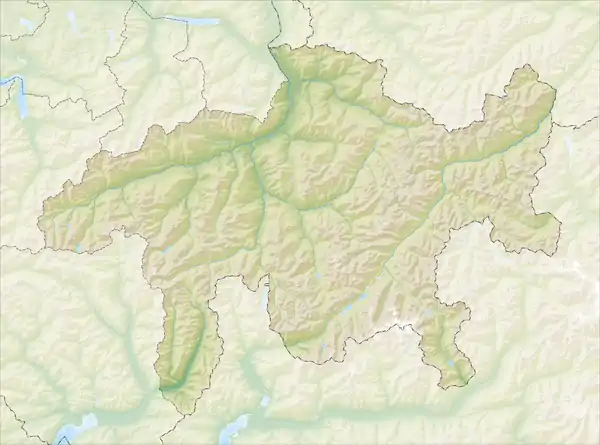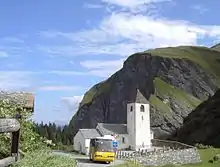Safien
Safien is a former municipality in the district of Surselva in the Swiss canton of Graubünden. The municipalities of Valendas, Versam, Safien and Tenna merged on 1 January 2013 into the new municipality of Safiental.[1]
Safien | |
|---|---|
 | |
 Coat of arms | |
Location of Safien | |
 Safien  Safien | |
| Coordinates: 46°40′N 9°18′E | |
| Country | Switzerland |
| Canton | Graubünden |
| District | Surselva |
| Area | |
| • Total | 100.58 km2 (38.83 sq mi) |
| Elevation | 1,315 m (4,314 ft) |
| Population (Dec 2011) | |
| • Total | 294 |
| • Density | 2.9/km2 (7.6/sq mi) |
| Time zone | UTC+01:00 (Central European Time) |
| • Summer (DST) | UTC+02:00 (Central European Summer Time) |
| Postal code(s) | 7107 |
| SFOS number | 3651 |
| Surrounded by | Casti-Wergenstein, Duvin, Flerden, Mathon, Nufenen, Pitasch, Portein, Präz, Riein, Sankt Martin, Sarn, Splügen, Sufers, Tenna, Tschappina, Vals |
| Twin towns | Bettingen (Switzerland) |
| Website | www SFSO statistics |
History
Safien is first mentioned in 1219 as Stosavia.[2]
Geography

Safien had an area, as of 2006, of 100.6 km2 (38.8 sq mi). Of this area, 45.6% is used for agricultural purposes, while 18.2% is forested. Of the rest of the land, 0.8% is settled (buildings or roads) and the remainder (35.4%) is non-productive (rivers, glaciers or mountains).[3]
The former municipality was the capital of the Safien sub-district of the Surselva district in the mid and upper Safien valley. The only other municipality in the sub-district was Tenna, which occupied the lower Safien valley. The valley is drained by the Rabiusa river.
The former municipality consists of the village of Safien-Platz (elevation: 1,350 m (4,430 ft)) and scattered hamlets and single farm houses throughout the valley.
Coat of arms
The blazon of the municipal coat of arms is Gules a Cross gyronny Argent and Sable[4] It is based on the simple design of the sub-district, with different colors.
Demographics
Safien had a population (as of 2011) of 294.[5] As of 2008, 0.3% of the population was made up of foreign nationals.[6] Over the last 10 years the population has decreased at a rate of -15%. Most of the population (as of 2000) speaks German (96.1%), with Italian being second most common ( 1.6%) and Albanian being third ( 1.6%).[3]
As of 2000, the gender distribution of the population was 49.5% male and 50.5% female.[7] The age distribution, as of 2000, in Safien is; 49 children or 15.9% of the population are between 0 and 9 years old and 43 teenagers or 14.0% are between 10 and 19. Of the adult population, 24 people or 7.8% of the population are between 20 and 29 years old. 37 people or 12.0% are between 30 and 39, 39 people or 12.7% are between 40 and 49, and 36 people or 11.7% are between 50 and 59. The senior population distribution is 30 people or 9.7% of the population are between 60 and 69 years old, 28 people or 9.1% are between 70 and 79, there are 18 people or 5.8% who are between 80 and 89,and there are 4 people or 1.3% who are between 90 and 99.[6]
In the 2007 federal election the most popular party was the SVP which received 62.4% of the vote. The next three most popular parties were the SP (18.8%), the FDP (7.4%) and the CVP (5.4%).[3]
In Safien about 61.7% of the population (between age 25-64) have completed either non-mandatory upper secondary education or additional higher education (either university or a Fachhochschule).[3]
Safien has an unemployment rate of 0.46%. As of 2005, there were 89 people employed in the primary economic sector and about 35 businesses involved in this sector. 15 people are employed in the secondary sector and there are 3 businesses in this sector. 32 people are employed in the tertiary sector, with 12 businesses in this sector.[3]
The historical population is given in the following table:[2]
| year | population |
|---|---|
| 1803 | 770 |
| 1850 | 685 |
| 1900 | 455 |
| 1950 | 453 |
| 2000 | 308 |
| 2010 | 305 |
References
- Amtliches Gemeindeverzeichnis der Schweiz published by the Swiss Federal Statistical Office (in German) accessed 2 January 2013
- Safien in German, French and Italian in the online Historical Dictionary of Switzerland.
- Swiss Federal Statistical Office accessed 02-Dec-2009
- Flags of the World.com accessed 02-Dec-2009
- Swiss Federal Statistics Office – STAT-TAB Ständige und Nichtständige Wohnbevölkerung nach Region, Geschlecht, Nationalität und Alter (in German) accessed 3 October 2012
- Graubunden Population Statistics Archived 2009-08-27 at the Wayback Machine (in German) accessed 21 September 2009
- Graubunden in Numbers Archived 2009-09-24 at the Wayback Machine (in German) accessed 21 September 2009